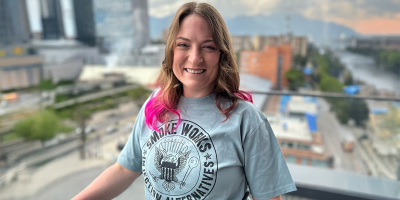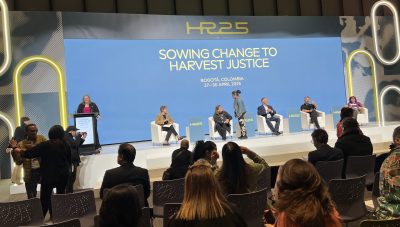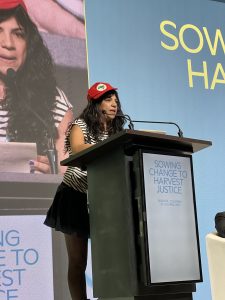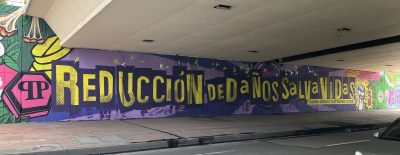Seeds of change: Reflections on the international harm reduction movement

People who use drugs are facing crises around the world. On top of increased risk for hepatitis C, HIV and toxic drug poisoning, the harm reduction programs that literally save their lives are under threat. In the face of repression and ever-shifting government priorities, cross-border solidarity is more vital than ever to defend the present and future of harm reduction.
This is the context in which thousands of people came together in Bogotá, Colombia, for the 28th Harm Reduction International Conference (HR25) in April. Attendees included frontline service providers, researchers, policy-makers, politicians, United Nations representatives, people who use drugs, sex workers and people working in the criminal-legal system. This year’s theme “Sowing Change to Harvest Justice” reflected a commitment to advancing social justice, equity and peace in the context of drug policy.
Harm reduction at the intersections
We do not ask for permission to exist, we come to demand reparations and justice.
Criminalization and prohibition have failed to reduce drug use, drug-related harms and drug-related crime, and only contribute to stigmatization, discrimination and death.
We cannot have justice without the protection of land and climate and the protection against development and resource extraction.
These were just a few of the powerful quotes that shook the room with thunderous cheers and applause from the audience at HR25.
A resounding theme of the conference was the importance of intersectional harm reduction approaches – recognizing how individual and community experiences are connected to diverse aspects of identity, culture, geography, socioeconomic status and political context. Plenary speakers stressed the intersections of harm reduction with other social justice movements and the need to build alliances to close the gaps between them, creating a more resilient, sustainable and unified movement.
Many speakers drew attention to the significant challenges faced by countries where substances are produced and the intersecting impacts of drug policies on individual and community health, climate and sustainability. They explored how drug policy is tied to global narco-trafficking, violence, displacement, climate damage, as well as the loss of Indigenous lands and cultural practices.

Calls for climate justice for drug-producing countries, land defence, labour rights, racial and reproductive justice, gender-affirming care, queer and trans rights and disability justice were woven throughout the sessions. Community-centred healing, decolonizing approaches to drug policy, as well as liberatory, feminist and abolitionist practices were all presented as essential for addressing intergenerational trauma, systemic oppression and state-sanctioned violence.
Speakers made it clear that intersectional harm reduction approaches must reject prohibition, racism, mass incarceration, capitalism, colonialism, patriarchy and imperialism. Instead, they must centre harm reduction practices grounded in care, compassion, mutual aid and radical tenderness – all moving towards shared goals of bodily autonomy, self-determination, human rights, freedom of movement and liberation.
Global harm reduction funding crises and opportunities
In addition to the political crises it faces, the harm reduction movement is also facing a related funding crisis. A recent report published by Harm Reduction International shows that funding for harm reduction remains persistently fragile, inconsistent and inadequate across the globe. Marginalized and disenfranchised communities bear the brunt of this pushback, with devastating impacts on their health and livelihoods.
Shrinking global funding for harm reduction is having a widespread impact on the sustainability of HIV treatment and prevention, as well as hepatitis C and harm reduction programs. Recent funding cuts undermine public health and social justice progress, reversing hard-won gains.
National and international donors have drastically scaled back many of their financial commitments to harm reduction, leaving life-saving harm reduction programs and services struggling with severe budget shortfalls. Funding for criminalization and punitive drug approaches are becoming more readily available, while resources for harm reduction and healthcare become evermore scarce.

Many speakers at HR25 called for the need to divest from ineffective and punitive drug policies and instead build reliable domestic funding opportunities for harm reduction programs and services. Without these, programs are trapped in vicious cycles of grant application writing, staff turnover, burnout and depleted resources.
In a session dedicated to addressing funding issues, speakers highlighted the potential of social enterprise models. These can help maintain and enhance the role of communities and civil society organizations when governments and international donors are the primary sources of funding. To secure future funding for harm reduction, speakers urged organizations to leverage existing partnerships, build new enduring partnerships among multidisciplinary teams and collaborate strategically across sectors rather than compete for limited resources.
Youth leadership: The future of harm reduction
Young people are rising as leaders in harm reduction – and their voices are essential to its future. In a session dedicated to uplifting youth voices and leadership, several presenters emphasized the importance of building and sustaining the next generation of harm reductionists and drug policy activists.
The meaningful involvement of youth and young people, especially in leadership and policy development, is crucial to ensuring inclusion, social justice and accessibility in harm reduction education, programs and policies. Presenters noted that while most drug policies affecting youth are still rooted in zero-tolerance and abstinence, young people continue to experiment and engage with drugs. Non-punitive and non-judgmental harm reduction approaches to youth substance use acknowledge that young people have always used drugs and will continue to use drugs, and that the best interventions offer them the tools to reduce harm, stay informed and empower them to be in control. Speakers from Youth RISE, an international youth-led network, noted that harm reduction information for youth is often limited to cannabis, alcohol and psychedelics, overlooking a need to provide health information for young people who are using opioids and other types of drugs.
Presenters also spoke about how youth-led organizations in drug policy and harm reduction sectors often struggle with a range of capacity issues that hinder their success, such as inadequate leadership transitions, insufficient institutional memory and lack of long-term strategy. They encouraged organizations to reflect on how leadership in grassroots youth movements can be done sustainably by documenting their work, building youth-friendly systems and creating tools for long-term success.
A young leader from Saskatoon, challenged the way “youth safety” is often weaponized against harm reduction, arguing that this narrative is counterintuitive and counterproductive. They pointed out that including youth in leadership positions without giving them training or support can do more harm than good. In their words, “it’s actually harm induction” because it can contribute to youth trauma and burnout when adequate supports aren’t provided.
Ensuring that young people are given resources and supported in leadership positions, is key to a future harm reduction movement that is relevant, capable, inclusive and empowering.
A path forward from crisis to solidarity
Harm reduction faces serious threats around the world and people who use drugs are bearing the burden of criminalization through state-sanctioned violence, systemic racism, mass incarceration and stigma. These realities hit hardest for racialized and Indigenous people, especially those who are women, queer, trans or nonbinary, or living in poverty.
But there is a path forward. By securing reliable domestic funding, bridging intersectional social justice movements and spring-boarding young people into leadership roles, we can create a more united and resilient movement.
Through cross-border solidarity and interdisciplinary collaboration, we can rise above – continuing to save lives, enable life and fight for justice and liberation. As we often say in harm reduction spaces, “Let’s take care of each other. We keep us safe.”

Alex Holtom is CATIE’s knowledge specialist in harm reduction programming.
